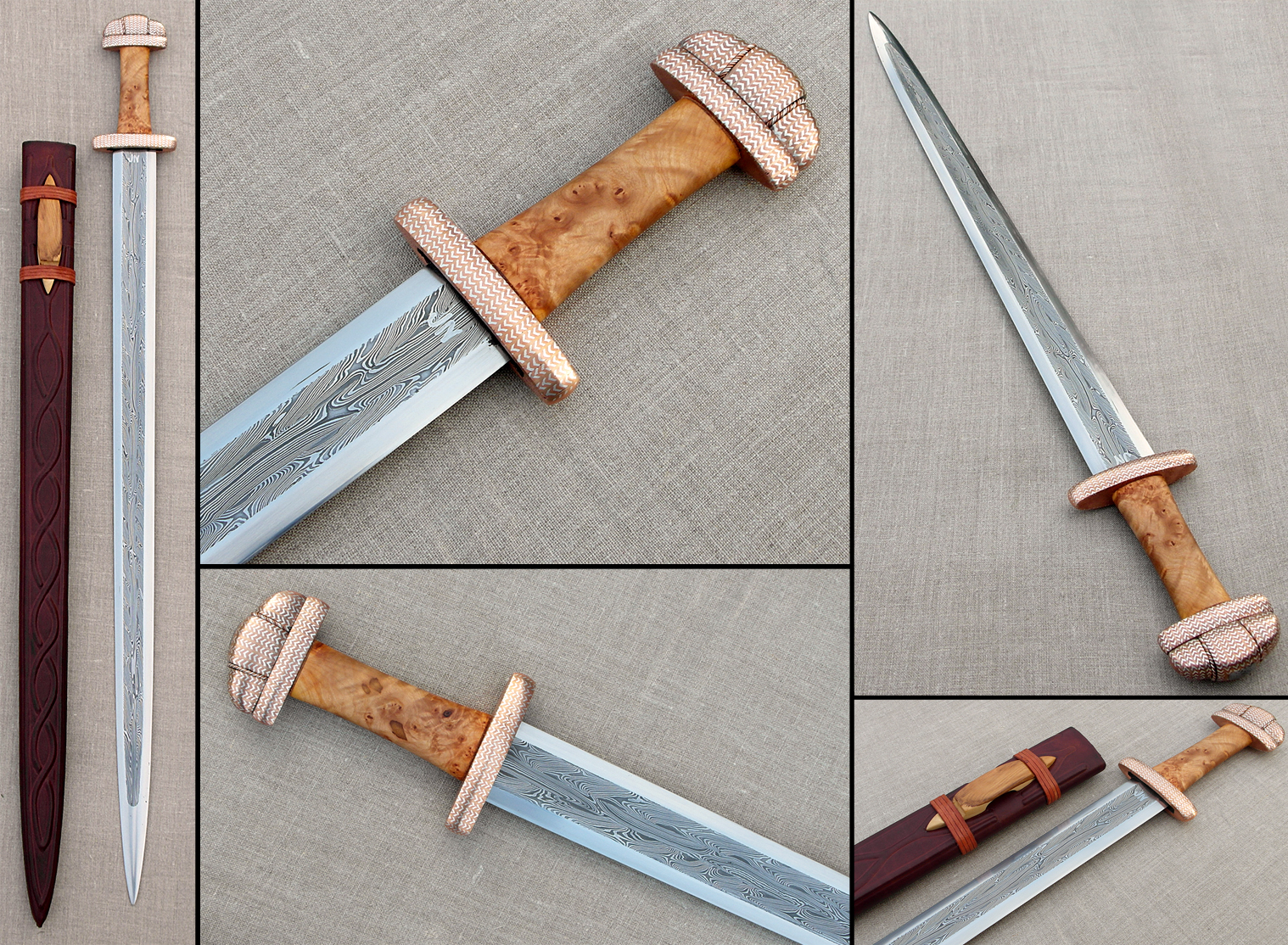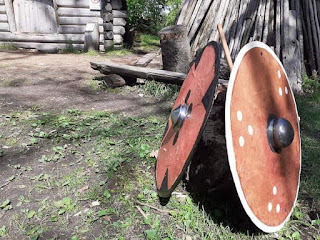Testing thin and thick shields against Viking Age weapons
We have build two shield with similar construction. Both are made just like the one we named Fat little sister, with the exception that the other (Skinny brother) is made of 6 mm thick planks and the fat one is made out of 10 mm thick planks.
Read about the construction of the Fat little sister from this blog post: https://hirdmenn.blogspot.com/2022/01/fat-little-sister-making-of-sturdy.html
The black paint is on the 6 mm thick shield and the white paint on the 10 mm thick shield.
Both are of spruce tree from the same order, so probably of the same age, maybe even from the same tree. The glueing was done the same way for both boards using same hide glue. Both have tanned leather facings from the same manufacturer. Both have raw hide edging from the same leather. The only difference is that the skinny one is painted with black iron oxide paint and the fat one has white chalk paint on it. Both are thinned down to 3 mm thickness on the edge, but the skinny one is shaved from 5 cm of the edge when the fat one is shaved from 10 cm distance from the edge. The fat one with white paint weighs 4,4 kg and the skinny one with black paint weighs 3,4 kg.
We have high trust in the ancient carpenters' skill on making the weapon he wanted to make. From some reason some shields are 10 mm thick, but some are thinner. The one from Tira swamp was as thin as 6 mm in the center.
Check out these two articles that mention shield thicknesses.
6 mm thick shield mentioned here: http://members.ozemail.com.au/~chrisandpeter/shield/tirskom.html
10 mm thick shields mentioned here: https://sagy.vikingove.cz/en/interview-with-rolf-f-warming/
If we choose to believe (as we do) that the carpenter could have made the kind of shield the warrior wanted, there has to be reasons for both kind of shields. In our experience the skinny (lighter, black) shield feels superior in every way, when we fight with modern weapon simulators. It's light so it's much faster and our movement overall becomes much faster. We can also fight longer with good technique before our arms start to hang too low like a tired boxers'. Thus the hypothesis is formed that the fat shield must be better in taking hits. This was put to test. We tested shields of 6 mm and 10 mm thickness against arrows, spears, axes and a sword.
TESTS:
Shooting the shields with a ~100 lb warbow
The bow is made by Mikke Reinikainen (the best bowyer in Finland in our opinion) and arrowtips are bought from https://shop.histofakt.de/. The arrows are put together by Joeli Takala who also shoots the bow. His draw lenght is 80 cm (31,5 inches). The shots are done from the distances of 10 and 5 meters. We had both bodkin like later arrow heads (piercing arrowtips) and earlier broadheads (cutting arrowtips).
VIDEO:
Analysing the results:
The results will be thoroughly analyzed in a future experimental archaeology publication by Hirdmenn member Sakari Saaristo, but preliminary results of this test are the following:
Both shields received one arrow hit (both from broadheads and from 10 m distance) that penetrated deeper than 10 cm. Here there was difference in the results between the shields, the thicker shield had 13 cm penetration, the thinner shield 18 cm penetration. There was no significant difference in the any of the other shots.
Cutting arrowtips (broadheads) penetrated somewhat deeper than piercing arrowheads (bodkins).
Arrows shot from 10 m and 5 m distance did not yield significantly different results.
Throwing and thrusting a light and heavy spear to the shields
We used two spears, one light javelin, and one heavier thrusting spear. Both are forged by bladesmith JT Pälikkö. They are his interpretations of iron age speartips. The throws are done from 3 meter and 1,5 meter distances, thrusts are done from a good fighting distance (about 1,5 meters), and step-and-thrust attacks a little bit further away (a little over 2 meters).
VIDEO:
Analysing the results:
Preliminary results of this test are the following:
We did not manage to get any of the light javelin throws to stick to the thin shield except one throw, during which a tree that held the shield acted as an anvil, preventing the shield to turn away much.
The light javelin throws stuck to the thicker shield almost every time, but did not penetrate deep.
Throws with the heavier spear did stuck to both shields almost every time, penetrating anything from 0,2 to 5 cm.
Sliding thrust with underarm spear did not get stuck into wither of the shields, but overarm thrusts did penterate both shields from 0,5 to 1 cm.
Step-and-thrust attacks penetrated somewhat deeper than regular sliding thrusts to both shields.
Hitting the shields with one handed axe
The one handed axe is forged by smith Timo Miettinen, as an interpretation of a viking age axe. Arttu helds the shields one handed, allowing them to turn naturally. Joeli hits the shield with one hand, using as much strength as is reasonable. The hits are done along and against the grain of the planks of the shields.
VIDEO:
Analysing the results:
Preliminary results of this test are the following:
Against the grain none of the hits penetrated either of the shields.
Along the grain all successfull hits (there was one hit when the axehead separated from the shaft) penetrated both the shields, depth of penetration varied from 1 to 4 cm.
The deeper the penetration, the harder it is to get the axe out of the shield.
Hitting the shields with a sword
The sword is made by Jarkko Niskanen and it represents an early viking age sword of Petersen's special type 2. The hits were performed at the edge of the shields by Joeli, along and against the grain of the shields, that were held in hand by Arttu. Also a thurst was conducted against the thick shield. After this another thrust hit the shield boss and bent the sword's tip, so we were unable to perform more thrusts.

The sword made by Jarkko Niskanen. The photos by him too.
VIDEO:
Analysing the results:
We found no difference in the depth of cuts done along and against the grain of the shields. There was also no significant difference between thin and thick shields in the depth of cuts.
Sword strikes that landed along the grain of a shield were almost impossible to pull out, while against the grain the sword was easy to remove from the shield.
Cuts along the grain did not damage the shields structurally, while cuts against the grain damaged the shields' integrity, leaving the cut plank portion unstable (wobbly).
Hitting the shields with a Dane axe (two handed axe)
The two handed axe was forged by smith Timo Miettinen as an interpretation of a late Viking Age Petersen type M axe (often called Dane axe). Joeli hits with it using two hands and maximum amount of power, Arttu is again holding the shields, allowing them to turn on impact.
VIDEO:
Analysing the results:
Cuts done against the grain of the shield did not manage to penetrate either of the shields.
Cuts done along the grain of the shield did manage to penetrate both the shields, to a depth of 2,3–3 cm.
We found no significant difference between the thin and thick shields.
Cutting the shields' edge with a spear
We also tested the shields against cuts done by a spear. The spear used was the same heavier thrusting spear as before. Joeli hit the edge of the shields with the spear, using it like a longsword by holding it two handed on the butt end. Arttu held the shield edge forward so that the cut was possible to perform. The hits were only done against the grain of the shields.
VIDEO:
Analysing the results:
The spear cut the edge of the thin shield 12,5 cm and the thick shield 5 cm. The difference might arise from the fact that the edge of the thick shield had been bashed several times with the shaft of the spear, which crushed the wood of the shield inside the leather, thus making the edge thicker and different in structure (grain of wood pieces going in many directions).
Fighting with broken shields
The shield work quite well after all that damage. Watch the video below to see for yourself.
This was another quite surprising result, but it would seem that one does not need to carry three shields to battle.
Conclusions
So even though there is a difference between the shields it does not seem to be even close to compensate the extra weight of the thicker shield. Why would they make such heavy shields? Is it just easier to make? Were they so much stronger that it didn't matter? Is there some other pleasure in carrying heavier gear, like how it sustains the test of bad weather? Did we test this wrong? Does the added weight make the shield better at breaking bones? (Please test this and send us the video.) What are the best ideas out there? Please write your opinions on the comment section. Tell us on Facebook, do your own test and show the results so we can compare.
Repairing the shields
The whole repair process took 3 hours from two workers on day 1 and 2 h from one worker on day 2.
On day 1 we filled all big cuts with hide glue. The deep cuts on the edge that went against the grain had done the most damade to the board. Those have now patches over them, made from the same hide piece the facing of the shields were made of. These seem to have fixed the "wobbling" of the planks really well. The second most significant damage was either glue breaking between the planks, or the whole plank broke through the whole lenght of the plank. This happened to both the shields. Re-attaching handles made the boards feel strong again. From this link you can see Arttu commenting on the repairs during day 1.
 |
| Shields after repair day 1. |
On day 2 we warmed the whole shield with a heating iron and we hope this renewed the glue that reacts to warmth and moisture. We cannot be sure that the glue between planks was fully renewed, but at least the hide is now again strongly attached and it holds the planks in place with the handle. The "wobble" disappeared. The shields feel really good again. We were able to spar with them right after the tests, but now they feel like new.
After ironing and drying the shields were super nice:
 |
| All our "authentic" shields fully repaired, shiny and chrome. (Ready for some blunt trauma...) |
To sum up:
After breaking these shields and seeing how well they work when broken and how fast they are to fix has added to our respect towards to this type of shields. Thicker spruce planks don't seem to make shields better than thin planks, so we don't know what to make of that.










Comments
Post a Comment